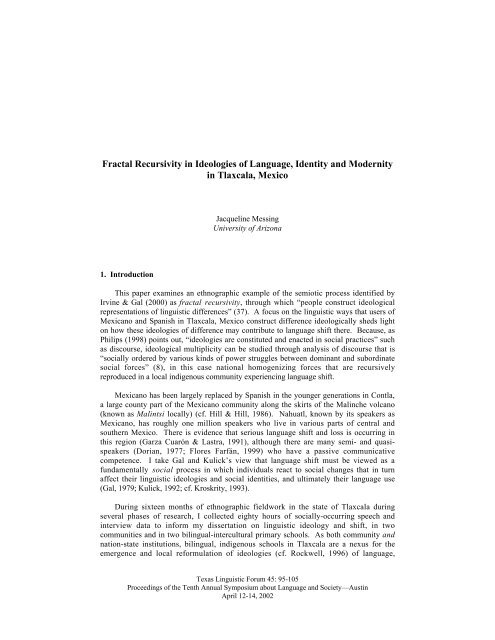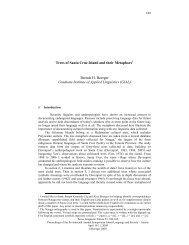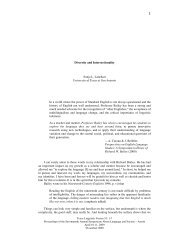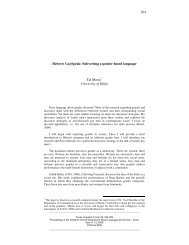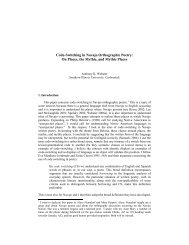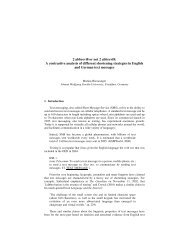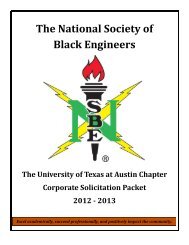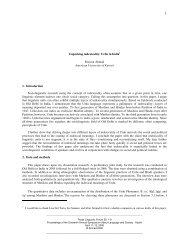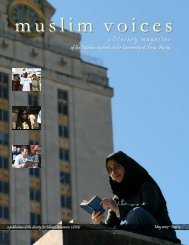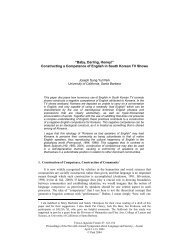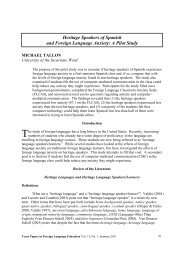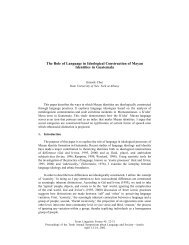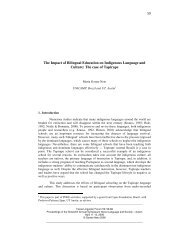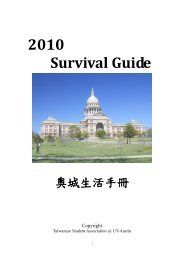Fractal Recursivity in Ideologies of Language, Identity and Modernity ...
Fractal Recursivity in Ideologies of Language, Identity and Modernity ...
Fractal Recursivity in Ideologies of Language, Identity and Modernity ...
Create successful ePaper yourself
Turn your PDF publications into a flip-book with our unique Google optimized e-Paper software.
<strong>Fractal</strong> <strong>Recursivity</strong> <strong>in</strong> <strong>Ideologies</strong> <strong>of</strong> <strong>Language</strong>, <strong>Identity</strong> <strong>and</strong> <strong>Modernity</strong><br />
<strong>in</strong> Tlaxcala, Mexico<br />
1. Introduction<br />
Jacquel<strong>in</strong>e Mess<strong>in</strong>g<br />
University <strong>of</strong> Arizona<br />
This paper exam<strong>in</strong>es an ethnographic example <strong>of</strong> the semiotic process identified by<br />
Irv<strong>in</strong>e & Gal (2000) as fractal recursivity, through which “people construct ideological<br />
representations <strong>of</strong> l<strong>in</strong>guistic differences” (37). A focus on the l<strong>in</strong>guistic ways that users <strong>of</strong><br />
Mexicano <strong>and</strong> Spanish <strong>in</strong> Tlaxcala, Mexico construct difference ideologically sheds light<br />
on how these ideologies <strong>of</strong> difference may contribute to language shift there. Because, as<br />
Philips (1998) po<strong>in</strong>ts out, “ideologies are constituted <strong>and</strong> enacted <strong>in</strong> social practices” such<br />
as discourse, ideological multiplicity can be studied through analysis <strong>of</strong> discourse that is<br />
“socially ordered by various k<strong>in</strong>ds <strong>of</strong> power struggles between dom<strong>in</strong>ant <strong>and</strong> subord<strong>in</strong>ate<br />
social forces” (8), <strong>in</strong> this case national homogeniz<strong>in</strong>g forces that are recursively<br />
reproduced <strong>in</strong> a local <strong>in</strong>digenous community experienc<strong>in</strong>g language shift.<br />
Mexicano has been largely replaced by Spanish <strong>in</strong> the younger generations <strong>in</strong> Contla,<br />
a large county part <strong>of</strong> the Mexicano community along the skirts <strong>of</strong> the Mal<strong>in</strong>che volcano<br />
(known as Mal<strong>in</strong>tsi locally) (cf. Hill & Hill, 1986). Nahuatl, known by its speakers as<br />
Mexicano, has roughly one million speakers who live <strong>in</strong> various parts <strong>of</strong> central <strong>and</strong><br />
southern Mexico. There is evidence that serious language shift <strong>and</strong> loss is occurr<strong>in</strong>g <strong>in</strong><br />
this region (Garza Cuarón & Lastra, 1991), although there are many semi- <strong>and</strong> quasispeakers<br />
(Dorian, 1977; Flores Farfán, 1999) who have a passive communicative<br />
competence. I take Gal <strong>and</strong> Kulick’s view that language shift must be viewed as a<br />
fundamentally social process <strong>in</strong> which <strong>in</strong>dividuals react to social changes that <strong>in</strong> turn<br />
affect their l<strong>in</strong>guistic ideologies <strong>and</strong> social identities, <strong>and</strong> ultimately their language use<br />
(Gal, 1979; Kulick, 1992; cf. Kroskrity, 1993).<br />
Dur<strong>in</strong>g sixteen months <strong>of</strong> ethnographic fieldwork <strong>in</strong> the state <strong>of</strong> Tlaxcala dur<strong>in</strong>g<br />
several phases <strong>of</strong> research, I collected eighty hours <strong>of</strong> socially-occurr<strong>in</strong>g speech <strong>and</strong><br />
<strong>in</strong>terview data to <strong>in</strong>form my dissertation on l<strong>in</strong>guistic ideology <strong>and</strong> shift, <strong>in</strong> two<br />
communities <strong>and</strong> <strong>in</strong> two bil<strong>in</strong>gual-<strong>in</strong>tercultural primary schools. As both community <strong>and</strong><br />
nation-state <strong>in</strong>stitutions, bil<strong>in</strong>gual, <strong>in</strong>digenous schools <strong>in</strong> Tlaxcala are a nexus for the<br />
emergence <strong>and</strong> local reformulation <strong>of</strong> ideologies (cf. Rockwell, 1996) <strong>of</strong> language,<br />
Texas L<strong>in</strong>guistic Forum 45: 95-105<br />
Proceed<strong>in</strong>gs <strong>of</strong> the Tenth Annual Symposium about <strong>Language</strong> <strong>and</strong> Society—Aust<strong>in</strong><br />
April 12-14, 2002
96<br />
<strong>Ideologies</strong> <strong>of</strong> <strong>Language</strong>, <strong>Identity</strong> <strong>and</strong> <strong>Modernity</strong><br />
identity, modernity, <strong>and</strong> the nation. My dissertation attempts an untangl<strong>in</strong>g <strong>of</strong> these<br />
multiple <strong>and</strong> conflict<strong>in</strong>g ideologies, produced <strong>in</strong> <strong>and</strong> through Tlaxcalan discourses <strong>in</strong> these<br />
communities <strong>and</strong> their attempts at bil<strong>in</strong>gual school<strong>in</strong>g. I suggest that these ideologies are<br />
organized through the production <strong>of</strong> three discourses that have local, regional, <strong>and</strong> national<br />
expressions: the discourse <strong>of</strong> salir adelante, or forg<strong>in</strong>g ahead, <strong>and</strong> improv<strong>in</strong>g one’s<br />
socioeconomic position; menosprecio, the denigration <strong>of</strong> <strong>in</strong>digenous identity; <strong>and</strong> third,<br />
the pro-<strong>in</strong>dígena or pro-<strong>in</strong>digenous discourse that promotes a positive attitude towards<br />
<strong>in</strong>digenous people (Mess<strong>in</strong>g, <strong>in</strong> preparation). In this paper, I focus on a semiotic<br />
expression <strong>of</strong> this ideological diversity, through examples <strong>of</strong> fractal recursivity <strong>in</strong><br />
Mexicano <strong>and</strong> Spanish from this corpus, to highlight ways that Tlaxcalans construct<br />
multiple local ideologies <strong>of</strong> language, identity <strong>and</strong> progress through talk, as they seek to<br />
def<strong>in</strong>e “the self as aga<strong>in</strong>st some imag<strong>in</strong>ed ‘Other’” (Ibid:39). 1<br />
2. “Monte es una palabra que encierra la discrim<strong>in</strong>ación:” <strong>Recursivity</strong> <strong>and</strong> local<br />
reproductions <strong>of</strong> discrim<strong>in</strong>ation<br />
In this paper, I will analyze narrative <strong>and</strong> <strong>in</strong>terview discourse from four people who<br />
live <strong>in</strong> different parts <strong>of</strong> the county <strong>of</strong> San Bernard<strong>in</strong>o Contla. <strong>Fractal</strong> recursivity<br />
“<strong>in</strong>volves the projection <strong>of</strong> an opposition” from one level to another (Irv<strong>in</strong>e & Gal,<br />
2000:38). As Don Luis, a resident <strong>of</strong> a geographically marg<strong>in</strong>alized town <strong>in</strong> Contla says<br />
<strong>in</strong> his narrative (l<strong>in</strong>es 4-5), Mexicano speakers are on the fr<strong>in</strong>ges: “ti..puebler<strong>in</strong>os ti..ticateh,<br />
orillas” (we [are] small town folk, we are on the fr<strong>in</strong>ges). In this example, the<br />
opposition consists <strong>of</strong> an unequal relationship between <strong>in</strong>digenous <strong>and</strong> non-<strong>in</strong>digenous<br />
people <strong>in</strong> Tlaxcala <strong>and</strong> Mexico, which here is reproduced <strong>in</strong> Contla <strong>in</strong> the way that local<br />
identities are iconically mapped onto certa<strong>in</strong> towns <strong>and</strong> sections <strong>of</strong> the county. The<br />
projection <strong>of</strong> the opposition here is the discrim<strong>in</strong>ation felt by <strong>in</strong>digenous Tlaxcalans from<br />
outside communities, which is reproduced with<strong>in</strong> the county studied. The concept <strong>of</strong><br />
fractal recursivity <strong>in</strong>vites us to consider oppositions that can be reproduced <strong>in</strong> multiple<br />
social contexts.<br />
San Bernard<strong>in</strong>o Contla’s dozen county sections consist <strong>of</strong> both <strong>of</strong>ficial neighborhoods<br />
<strong>and</strong> politically <strong>in</strong>corporated towns which <strong>of</strong>fer rich opportunities for comparison. The<br />
speakers whose voices we hear <strong>in</strong> this paper are from the towns <strong>of</strong> San José Aztatla, San<br />
Felipe Cuahutenco, <strong>and</strong> Contla, the center <strong>of</strong> the county, known as the county cabecera (or<br />
head town). There is an association here between people <strong>and</strong> the l<strong>and</strong> on which they <strong>and</strong><br />
their families live <strong>and</strong>/or cultivate; there is a connection between geography, identity <strong>and</strong><br />
language, the ma<strong>in</strong> dist<strong>in</strong>ction be<strong>in</strong>g between centro (Contla) <strong>and</strong> monte (the mounta<strong>in</strong>/<br />
mount) (Nut<strong>in</strong>i, 1968). There is an ideology that be<strong>in</strong>g from the towns <strong>in</strong> the higher<br />
elevations <strong>of</strong> the county (“Ser del monte”) implies <strong>in</strong>digenousness, marked by greater use<br />
<strong>of</strong> Mexicano <strong>and</strong> greater poverty. An <strong>in</strong>formant expla<strong>in</strong>ed that the term monte “es una<br />
palabra que encierra la discrim<strong>in</strong>ación” (is a term that encloses discrim<strong>in</strong>ation); it <strong>in</strong>dexes<br />
a local identity “subord<strong>in</strong>ate” to the “dom<strong>in</strong>ant” one <strong>of</strong> the centro. Local ideologies work<br />
semiotically as people map dom<strong>in</strong>ant <strong>and</strong> subord<strong>in</strong>ate identities onto these local regions.<br />
1 For many conversations helpful to this analysis, <strong>and</strong> general support dur<strong>in</strong>g fieldwork <strong>in</strong> Mexico, I<br />
would like to thank José Antonio Flores Farfán, Elsie Rockwell, Refugio Nava Nava <strong>and</strong> Ramos<br />
Rosales Flores. For f<strong>in</strong>ancial support <strong>of</strong> my field research <strong>and</strong> data analysis, I thank the University<br />
<strong>of</strong> Arizona, the Fulbright Commission, <strong>and</strong> the Spencer Foundation. I am grateful to Susan Philips,<br />
Jane Hill, Hortensia Caballero-Arias <strong>and</strong> Kathe Managan for their <strong>in</strong>sightful comments on an earlier<br />
version <strong>of</strong> this paper.
Mess<strong>in</strong>g, J. 97<br />
The political <strong>and</strong> socioeconomic subord<strong>in</strong>ation experienced by <strong>in</strong>digenous<br />
communities <strong>in</strong> Mexico (cf. Bonfil Batalla, [1987]1994; Collier, 1994; García Cancl<strong>in</strong>i,<br />
1993) is <strong>in</strong>dexed by the discrim<strong>in</strong>ation mentioned by this resident <strong>of</strong> Contla, <strong>and</strong> is<br />
coupled with a widespread ignorance about <strong>in</strong>digenous languages; I heard from a medical<br />
doctor <strong>in</strong> a Tlaxcala city that her maid, who was from a rural town, did not speak any<br />
Nahuatl, but “ella ya habla normal” (she already speaks normal). Such examples <strong>of</strong><br />
l<strong>in</strong>guistic ignorance are bound up with discrim<strong>in</strong>ation that is a part <strong>of</strong> the discourse <strong>of</strong><br />
menosprecio 2 that is recursively reproduced <strong>in</strong> Contla, usually by those who hold<br />
economic <strong>and</strong> political power, to differentiate themselves from those who are markedly<br />
<strong>in</strong>digenous. The Mexicano language is an icon <strong>of</strong> local <strong>in</strong>digenous identity <strong>of</strong> which many<br />
Contla county residents are proud, while others try to distance themselves from mark<strong>in</strong>g<br />
themselves as <strong>in</strong>dígena, <strong>in</strong>digenous.<br />
3. <strong>Recursivity</strong> <strong>in</strong> discourses <strong>of</strong> language, identity <strong>and</strong> progress: Four voices<br />
As the follow<strong>in</strong>g examples will show, this differentiation is recursively reproduced<br />
throughout the county, <strong>and</strong> concentrated around the dist<strong>in</strong>ctions residents map out<br />
between, <strong>and</strong> onto centro <strong>and</strong> monte. As part <strong>of</strong> a national ideology concerned with<br />
develop<strong>in</strong>g Mexico <strong>in</strong>to a “modern,” “first world” nation, the discourse <strong>of</strong> salir adelante<br />
(which has national, regional <strong>and</strong> local expressions) is produced locally by those seek<strong>in</strong>g<br />
economic betterment. Contla has seen the <strong>in</strong>dustrialization <strong>of</strong> its artisan-based textile<br />
<strong>in</strong>dustry, <strong>and</strong> a desire for “modern” goods has accompanied the surge <strong>of</strong> factory-based<br />
employment. To achieve desired personal <strong>and</strong> economic progress, many <strong>in</strong>digenous<br />
people <strong>in</strong> Tlaxcala believe that the past must be shed <strong>in</strong> order to embrace a new order.<br />
Speak<strong>in</strong>g an Indian language <strong>in</strong> Mexico is considered the primary marker <strong>of</strong> an <strong>in</strong>digenous<br />
identity. One mother told me that her daughter wanted to buy an expensive br<strong>and</strong> <strong>of</strong> shoes<br />
for her graduation because she did not want to “look Indian.” In this example, the<br />
symbolic resources employed by this eleven year old girl show that local residents<br />
sometimes attempt to orient away from a marked <strong>in</strong>digenous identity.<br />
[I am sorry. What do Four Voices <strong>in</strong> the section subtitle refer to? The four people<br />
<strong>in</strong>terviewed <strong>in</strong> the follow<strong>in</strong>g sections?]<br />
4. Don Luis<br />
The data analyzed here were chosen because the quotes are representative <strong>of</strong> a variety<br />
<strong>of</strong> op<strong>in</strong>ions from residents <strong>of</strong> different parts <strong>of</strong> Contla. The first speaker, Don Luis, 3 is a<br />
Mexicano-dom<strong>in</strong>ant man <strong>in</strong> his mid-seventies, who talks about the difficulty <strong>of</strong> life <strong>in</strong> the<br />
2<br />
The discourses <strong>of</strong> menosprecio <strong>and</strong> salir adelante have been named accord<strong>in</strong>g to local usage <strong>of</strong><br />
these terms.<br />
3<br />
This name <strong>and</strong> all others <strong>in</strong> this paper are pseudonyms.
98<br />
<strong>Ideologies</strong> <strong>of</strong> <strong>Language</strong>, <strong>Identity</strong> <strong>and</strong> <strong>Modernity</strong><br />
past compared to today. As he says <strong>in</strong> the first l<strong>in</strong>e, he considers his family to be small<br />
town folk, who live on the socioeconomic <strong>and</strong> geographic fr<strong>in</strong>ges <strong>of</strong> Contla. 4<br />
(1) Don Luis<br />
1 pos itech <strong>in</strong> nican ca tlahtec, ca miec este pos, bueno de nican to:ntziliz<br />
2<br />
3<br />
well here <strong>in</strong> this place[room], I will tell you that, well, well, from here from our…<br />
4 ti... puebleri:nos ti ti... ticateh, este orillas bueno<br />
5<br />
6<br />
we are small town folk, we we are on the fr<strong>in</strong>ges well<br />
7 amo ca mas este posibilidad para para tivivirozqueh amo ca s<strong>in</strong>o que, de lo<br />
8 contrario, pues<br />
9<br />
10<br />
here is not much more possibility for us to live, there is not but on the contrary, well<br />
11 este. tisufriroah amo de n<strong>in</strong> ca, <strong>in</strong> tlaxcal ca, nada más salir para ce factoria para ce<br />
12 calaquiz<br />
13 um. we suffered not from this [eat<strong>in</strong>g], tortilla there is, only to go out to a factory for<br />
14<br />
15<br />
one to enter<br />
16 ce yeca yocalaquito huan ce q’pia posibilidad, pos amo solamente hasta ic Santa Ana<br />
17 yahweh<br />
18 one already went has [work] possibilities, well no only all the way to Santa Ana do<br />
19<br />
20<br />
they go<br />
21 ..naxan actualmente yen coco:neh ye quitemoa n<strong>in</strong>vida, ye quitemoa n<strong>in</strong>vida, ah<br />
22<br />
23<br />
now the youth look for their livelihood, they look for their livelihood<br />
24 itech fábricas tanto fabricas yeca, ompa tequiti-tihue para ye... yequipia mas<br />
25 cecentavo<br />
26 <strong>in</strong> factories so many factories there are today there they go to work to [f<strong>in</strong>ally] have a<br />
27<br />
28<br />
cent<br />
29 pero anteriormente <br />
30 but before .<br />
4 TRANSCRIPTION CONVENTIONS: Italics are used to <strong>in</strong>dicate text <strong>in</strong> Mexicano or Spanish; :<br />
is a long vowel marker; Boldface is used for emphasis; [ ] brackets enclose additional <strong>in</strong>formation;<br />
<strong>and</strong> encloses utterances said with emphasis.
Mess<strong>in</strong>g, J. 99<br />
Don Luis’s narrative, excerpted here, shows the difficulty <strong>of</strong> salir adelante, <strong>of</strong> forg<strong>in</strong>g<br />
ahead <strong>and</strong> ek<strong>in</strong>g out a liv<strong>in</strong>g <strong>in</strong> San Jose Aztatla, a town on the upper slopes <strong>of</strong> the<br />
county. 5 The factory work he mentions <strong>in</strong> l<strong>in</strong>e 11 is part <strong>of</strong> a century old textile <strong>in</strong>dustry<br />
that has <strong>in</strong>creas<strong>in</strong>gly shifted from <strong>in</strong>formal work <strong>in</strong> households (weav<strong>in</strong>g blankets on large<br />
wooden looms) to factory shift labor, consist<strong>in</strong>g ma<strong>in</strong>ly <strong>of</strong> production <strong>of</strong> yarn from raw<br />
materials. As he expla<strong>in</strong>s, as a charcoal maker (hornero) <strong>and</strong> pulque producer Don Luis is<br />
on the economic fr<strong>in</strong>ges. His is the life <strong>of</strong> rural poverty that younger generations hope to<br />
improve upon, surfac<strong>in</strong>g <strong>in</strong> discourses <strong>of</strong> salir adelante, forg<strong>in</strong>g ahead. Recursive<br />
oppositions between old <strong>and</strong> new, <strong>and</strong> between <strong>in</strong>digenous identities with<strong>in</strong> Contla are a<br />
part <strong>of</strong> these discourses.<br />
5. Doña Paul<strong>in</strong>a<br />
The follow<strong>in</strong>g three examples <strong>of</strong> recursivity are excerpts from <strong>in</strong>terviews done<br />
towards the end <strong>of</strong> my fieldwork, after many conversations had taken place with these<br />
<strong>in</strong>terlocutors. The questions I asked them here were to rem<strong>in</strong>d them <strong>of</strong> discussions we had<br />
previously had on a more <strong>in</strong>formal basis. In the follow<strong>in</strong>g <strong>in</strong>terview excerpt, the discourse<br />
<strong>of</strong> menosprecio, <strong>of</strong> denigration, surfaces <strong>in</strong> relation to the dist<strong>in</strong>ction between centro <strong>and</strong><br />
monte.<br />
The Spanish deictics aquí/acá (here), allí (there), <strong>and</strong> allá (over there farther) that the<br />
speakers use <strong>in</strong> these <strong>in</strong>terviews mark their location on the mounta<strong>in</strong> <strong>in</strong> terms <strong>of</strong> the<br />
center/mounta<strong>in</strong> dist<strong>in</strong>ction, which highlights their identity as a member <strong>of</strong> a community<br />
<strong>in</strong> a particular location <strong>in</strong> the Mal<strong>in</strong>tsi area. Aquí or acá is used by the speaker to <strong>in</strong>dicate<br />
his/her place on the mounta<strong>in</strong>, referr<strong>in</strong>g to the others as allí or allá (there <strong>and</strong> over there).<br />
To highlight this usage, which shows the local relation <strong>of</strong> language <strong>and</strong> identity to place, I<br />
have marked these words <strong>in</strong> boldface.<br />
In example two, this <strong>in</strong>terview took place <strong>in</strong> San Felipe Cuahutenco (on the upper<br />
slopes <strong>of</strong> the Mal<strong>in</strong>tsi), with Doña Paul<strong>in</strong>a, a bil<strong>in</strong>gual woman <strong>in</strong> her late fifties, who is the<br />
gr<strong>and</strong>mother <strong>of</strong> a student <strong>in</strong> the Contla school which I was observ<strong>in</strong>g. The goal was to<br />
capture an anecdote about discrim<strong>in</strong>ation that she had told me <strong>in</strong> one <strong>of</strong> several earlier<br />
<strong>in</strong>formal conversations, about women from the monte who went to the river down the<br />
mounta<strong>in</strong> to wash cloth<strong>in</strong>g. Here she responds to my question.<br />
(2) Doña Paul<strong>in</strong>a<br />
1 J: Una vez lo platicamos de que en el monte es diferente que más para abajo del<br />
2 monte. Yo no sé si es porque se habla más Mexicano, a veces acá. Y que a veces ha<br />
3 habido discrim<strong>in</strong>ación entre personas [mhhmm] que son, o con personas que son del<br />
4 monte. Mas antes, [mhhmm] antes cu<strong>and</strong>o las señoras iban al río a lavar, y a…<br />
5 A prelim<strong>in</strong>ary analysis <strong>of</strong> this narrative was presented at the 2000 meet<strong>in</strong>gs <strong>of</strong> the L<strong>in</strong>guistic<br />
Association <strong>of</strong> the Southwest, <strong>in</strong> Puebla, Mexico (Mess<strong>in</strong>g & Nava Nava 2000). The transcription<br />
<strong>and</strong> translations <strong>of</strong> the entire narrative, excerpted here, was a collaborative project between Refugio<br />
Nava Nava <strong>and</strong> myself, with detailed feedback from Jane Hill.
100<br />
<strong>Ideologies</strong> <strong>of</strong> <strong>Language</strong>, <strong>Identity</strong> <strong>and</strong> <strong>Modernity</strong><br />
5 J: Once we talked about that on the mounta<strong>in</strong> it’s different than more below the<br />
6 mounta<strong>in</strong>.<br />
7 I don’t know if it’s because more Mexicano is spoken sometimes here. And that<br />
8 sometimes there has been discrim<strong>in</strong>ation between people [mhhmm] who are, or with<br />
9 people who are from the mounta<strong>in</strong>. Before, earlier [mhhmm] when the women went<br />
10 to the river to wash, <strong>and</strong> to…<br />
11<br />
12 P: sí, mucho. Eso sí, la verdad, hasta hoy y luego algunos, así de los que me llevo sí<br />
13 los reprocho.<br />
14 P: Yes, a lot. That’s right, truly, up until today s<strong>in</strong>ce then some, with those I get<br />
15 along with I reproach them.<br />
16<br />
17 J: ah, ¿del centro?<br />
18 J: Ah, from the center [<strong>of</strong> town]?<br />
19<br />
20 P: sí<br />
21 P: Yes<br />
22<br />
23 J: los con quién Ud. ...<br />
24 J: those with whom you...<br />
25<br />
26 P: sí<br />
27 P: yes<br />
28<br />
29 J: ah, ¿y de qué los reprocha?<br />
30 J: ah, <strong>and</strong> what do you reproach them for?<br />
31<br />
32 P: Porque este, antes nos discrim<strong>in</strong>aban, mucho. Por… lo que so.., como salvajes,<br />
33 así mal nos trataban. Nos dicen... como animales salvajes, como, bueno [mmhmm].<br />
34 Pero yo creo anteriormente a lo mejor sí, era más diferente ellos que nosotros.<br />
35 P: Because um, it’s that before they discrim<strong>in</strong>ated [aga<strong>in</strong>st] us <strong>in</strong>, a lot. Because...<br />
36 what [?]…, like savages, that badly they treated us. They call us… savage animals,<br />
37 like, well [mmhmm]. But I th<strong>in</strong>k before, yes, they were more different than we.<br />
38<br />
39 J: aah<br />
40<br />
41 P: Por el motivo de que ellos lo hablaban más en Español, y nosotros no. Entonces,<br />
42 pues, más todavía teníamos dist<strong>in</strong>ción aquí, para ellos, y más que nada pues allí...<br />
43 mpezaron, según, ya estaban progres<strong>and</strong>o de antes. Allí empezaron a trabajar la<br />
44 cobija de telar, entonces según ellos estaban de progreso, y aquí no, porque aquí<br />
45 siempre hay que vender leña, hay q' acarriar agua de allá, entonces por ese por ese<br />
46 ist<strong>in</strong>ción nos dist<strong>in</strong>guían así, discrim<strong>in</strong>aciones para nosotros.<br />
47 P: Because <strong>of</strong> the motive that they would speak more <strong>in</strong> Spanish, <strong>and</strong> we didn’t.<br />
48 Therefore, well, we even more [<strong>in</strong> relation to them] had [a] difference here for them,<br />
49 <strong>and</strong> more than anyth<strong>in</strong>g, well there they began, supposedly, they were already<br />
50 progress<strong>in</strong>g s<strong>in</strong>ce earlier. There they began to labor blankets from the loom, then<br />
51 accord<strong>in</strong>g to them they were <strong>in</strong> progress, <strong>and</strong> here no, because here we always need<br />
52 to sell firewood, one has to carry water from over there, so because <strong>of</strong> that difference<br />
53 they dist<strong>in</strong>guished us this way, discrim<strong>in</strong>ations for us.<br />
54<br />
55 J: mmhmm, bien duro, que duro.
Mess<strong>in</strong>g, J. 101<br />
56 J: mhhmm, very hard, how hard.<br />
57<br />
58 P: sí, es mucho<br />
59 P: yes, it’s a lot<br />
60<br />
61 J: y ya....<br />
62 J: <strong>and</strong> now...<br />
63<br />
64 P: no, pues ahora ya no, ya..., por lo que, este.., luego me dice [son’s name] como,<br />
65 como son. Tal vez aquí hasta ya mejoró, mejor aquí que allá. Porque..., este...,<br />
66 [mmhmm] pues aquí ya tiene, ya tiene más que nada, lo <strong>in</strong>dispensable es el agua y<br />
67 servicio,[mmhmm] las calles pues más o menos están todos arreglados. Este, los que<br />
68 es terrazería, a fuerza los mantiene, los repara y allá no.<br />
69 P: no, well now not anymore, now, for what, um, [son’s name] tells me how, how are<br />
70 those from over there. Maybe it’s even improved already, better here than over<br />
71 there. Because um, [mmhmm] well here there is already, there already is more than<br />
72 anyth<strong>in</strong>g, the m<strong>in</strong>imum is water <strong>and</strong> utilities, [mmhmm] the roads well are more or<br />
73 less fixed up. Um, the ones that are dirt roads, <strong>of</strong> course they ma<strong>in</strong>ta<strong>in</strong> them, repair<br />
74 them <strong>and</strong> over there no.<br />
The discourse <strong>of</strong> menosprecio is explicit as Doña Paul<strong>in</strong>a describes the terrible<br />
mistreatment <strong>of</strong> Cuahutenco residents by other residents <strong>of</strong> their county from the center,<br />
who at the time, forty years ago, were all speakers <strong>of</strong> Mexicano as well. The<br />
discrim<strong>in</strong>ation felt by <strong>in</strong>digenous people, from people outside the Contla county is<br />
recursively reproduced <strong>in</strong> these local ideologies <strong>of</strong> identity <strong>and</strong> place, <strong>and</strong> marked by the<br />
consistent use <strong>of</strong> deictic terms <strong>in</strong> Spanish for “here” <strong>and</strong> “there,” such as <strong>in</strong> l<strong>in</strong>es 42-45<strong>and</strong><br />
65-68. While th<strong>in</strong>gs have improved to the po<strong>in</strong>t that Doña Paul<strong>in</strong>a can now talk to centro<br />
residents about their prejudices, the oppositions between “here” <strong>and</strong> “there” are still<br />
clearly marked <strong>in</strong> her discourse. For Paul<strong>in</strong>a, progress is measured <strong>in</strong> terms <strong>of</strong> access to<br />
wage labor, roads, transportation, water <strong>and</strong> other services, <strong>and</strong> connected to the greater<br />
<strong>and</strong> lesser degree <strong>of</strong> speak<strong>in</strong>g Mexicano.<br />
6. Maestro Eustalio<br />
In the third example, Maestro Eustalio is a bil<strong>in</strong>gual speaker <strong>in</strong> his mid-forties also<br />
from Cuahutenco. He is a teacher. In his <strong>in</strong>terview Eustalio expla<strong>in</strong>ed that for the most<br />
part, to this day few people from the center married <strong>in</strong>to families <strong>in</strong> his town, <strong>and</strong> that<br />
certa<strong>in</strong> centro/ monte differences were still observable, <strong>in</strong>clud<strong>in</strong>g use <strong>of</strong> Mexicano. On<br />
l<strong>in</strong>es 5 <strong>and</strong> 6 he says: “Tienen ese complejo los de acá de Contla, quién sabe porque.<br />
Pero este, todavía no sienten como, no sé, como algo menos que ellos, los de por ahí<br />
arriba, los del monte” (They have this complex those from here from Contla, who knows<br />
why. But um, they don’t still feel as if, I don’t know, like someth<strong>in</strong>g less then them, those<br />
from over there above, those from the mounta<strong>in</strong>.) In the follow<strong>in</strong>g <strong>in</strong>terview excerpt he<br />
elaborates his perspective on these differences.<br />
(3) Maestro Eustalio<br />
1 J: Luego otras personas me empezaron a platicar de la diferencia entre como lo<br />
2 pusieron ellos el monte y más abajo. Así lo ve usted todavía?<br />
3 J: Then other people began to talk to me about the difference between, the way they<br />
4 put it was the mounta<strong>in</strong> <strong>and</strong> below. Do you see it that way still?
102<br />
<strong>Ideologies</strong> <strong>of</strong> <strong>Language</strong>, <strong>Identity</strong> <strong>and</strong> <strong>Modernity</strong><br />
5<br />
6 E: Sí todavía. Tienen ese complejo los de acá de Contla, quién sabe porque. Pero<br />
7 este, todavía no sienten como, no sé, como algo menos que ellos, los de por ahí<br />
arriba,<br />
8 los del monte. […]<br />
9 E: Yes still. They have this complex those from here from Contla, who knows why.<br />
10 But um, they don’t still feel as if I don’t know like someth<strong>in</strong>g less thanthem, those<br />
11 from over there above, those from the mounta<strong>in</strong>.<br />
12<br />
13 J: ¿Y cree usted que sí se conserve el idioma mejor en la zona de arriba más que en<br />
14 la de abajo?<br />
15 J: And do you th<strong>in</strong>k that the language is better conserved <strong>in</strong> the higher zone more<br />
16 than <strong>in</strong> the lower area?<br />
17<br />
18 E: Pues, yo creo que sí, Bueno todavía se sigue habl<strong>and</strong>o más allá arriba que aquí<br />
19 abajo.[...]<br />
20 Pero aquí en Contla ya no quieren. Yo creo que es una de las situaciones y también,<br />
21 nosotros nos ven de esa manera, porque pues todavía usamos el idioma, y a veces<br />
22 viene gente de allá, vienen en carro y se vienen platic<strong>and</strong>o en Nahuatl. Y nomás que<br />
23 vienen, que hacen así.<br />
24 E: Well, I th<strong>in</strong>k so, well it’s still be<strong>in</strong>g spoken more over there above than here<br />
25 elow. […] But here <strong>in</strong> Contla they don’t want to anymore. I th<strong>in</strong>k that it’s one <strong>of</strong> my<br />
26 situations on the way to we. They see us <strong>in</strong> this way because we still use the<br />
27 language <strong>and</strong> sometimes people come from there, they come by car <strong>and</strong> they come<br />
28 hatt<strong>in</strong>g <strong>in</strong> Nahuatl. And only they come, who do <strong>in</strong> this way.<br />
For Don Eustalio, the centro/monte dist<strong>in</strong>t<strong>in</strong>ction is a “complex” that the people <strong>in</strong> the<br />
center <strong>of</strong> town have. It is <strong>in</strong>terest<strong>in</strong>g to note that this <strong>in</strong>terview was done <strong>in</strong> the lower part<br />
<strong>of</strong> the mounta<strong>in</strong>, rather than <strong>in</strong> the teacher’s town; thus Eustalio’s deictic references are<br />
from the vantage po<strong>in</strong>t <strong>of</strong> the center <strong>of</strong> town. Therefore, when he says <strong>in</strong> l<strong>in</strong>es 21 <strong>and</strong> 22<br />
“a veces viene gente de allá, vienen en carro y se vienen platic<strong>and</strong>o en Nahuatl,”<br />
“sometimes people come from there, [mean<strong>in</strong>g from his town to here, referr<strong>in</strong>g to where<br />
we were talk<strong>in</strong>g, further down the mounta<strong>in</strong>], they come by car <strong>and</strong> they come speak<strong>in</strong>g<br />
Nahuatl.” He also emphasizes the fact that today many Cuahutenco residents are now able<br />
to own cars, <strong>and</strong> they drive down the mounta<strong>in</strong> to the center, at the same time that they are<br />
speak<strong>in</strong>g <strong>in</strong> Mexicano. Eustalio <strong>in</strong> this example makes the explicit po<strong>in</strong>t that one can<br />
ma<strong>in</strong>ta<strong>in</strong> elements <strong>of</strong> <strong>in</strong>digenousness, such as speak<strong>in</strong>g Mexicano, <strong>and</strong> also own a car – a<br />
local symbol <strong>of</strong> progress, <strong>of</strong> salir adelante. 6<br />
7. Maestra Rosa<br />
In my last example, Rosa is a teacher who lives <strong>in</strong> the center <strong>of</strong> Contla; she is a semispeaker<br />
<strong>of</strong> Mexicano, <strong>in</strong> her late thirties. This <strong>in</strong>terview marked the culm<strong>in</strong>ation <strong>of</strong> many<br />
prior conversations over a year about language, local ideologies, <strong>and</strong> education <strong>in</strong><br />
Tlaxcala. I was curious how she would recapitulate aspects <strong>of</strong> these conversations while<br />
6 The importance <strong>of</strong> the speaker’s emphasis <strong>of</strong> driv<strong>in</strong>g a car down the mounta<strong>in</strong> from the monte to<br />
the centro is particularly strong when considered <strong>in</strong> light <strong>of</strong> many stories I heard about life <strong>in</strong> Contla<br />
a decade ago, before the ma<strong>in</strong> roads were paved, <strong>and</strong> before there was public transportation. Prior to<br />
this, most people walked the two hours down the mounta<strong>in</strong> <strong>and</strong> back, rely<strong>in</strong>g on burros to carry their<br />
loads. To own a car is a prime symbol <strong>of</strong> progress <strong>in</strong> the discourse <strong>of</strong> salir adelante.<br />
102
Mess<strong>in</strong>g, J. 103<br />
be<strong>in</strong>g recorded. Rosa’s family is from the centro, but she is very dedicated to the teach<strong>in</strong>g<br />
<strong>of</strong> Mexicano; Rosa suggested that the discrim<strong>in</strong>ation by those <strong>in</strong> the center <strong>of</strong> Contla had<br />
as much to do with local l<strong>and</strong> struggles as with language, thereby suggest<strong>in</strong>g another layer<br />
<strong>of</strong> complexity to the recursivity <strong>of</strong> the centro/monte dist<strong>in</strong>ction.<br />
(4) Maestra Rosa<br />
1 J: Entonces ¿cómo ves tú las diferencias dentro del propio municipio de Contla en<br />
2 cuánto a dónde se hablaba más, o… pero también en cuanto a, a, bueno al<br />
3 menosprecio y como….?<br />
4 J: Then how do you see the differences with<strong>in</strong> the county <strong>of</strong> Contla proper <strong>in</strong> term <strong>of</strong><br />
5 where more [Mexicano] is spoken, or... but also <strong>in</strong> terms <strong>of</strong>, <strong>of</strong> well menosprecio <strong>and</strong><br />
6 how...?<br />
7<br />
8 M: Sí, era un menosprecio, eso sí es <strong>in</strong>discutible. Eh, Por ejemplo a los de<br />
9 Cuahutenco les decían que eran, eran este... la gente más humilde pero decían más<br />
10 atrasada, más... eh, <strong>in</strong>culta pues, por el hecho de hablar Náhuatl.<br />
11 M: Yes, it was a menosprecio, that <strong>in</strong>deed is unarguable. For example for those from<br />
12 Cuahutenco people would say they were um… the most… eh, humble people but<br />
13 people would say more backward, more… uncouth[uneducated] well, because <strong>of</strong> the<br />
14 fact <strong>of</strong> speak<strong>in</strong>g Nahuatl.<br />
15<br />
16 Cu<strong>and</strong>o llegaban acá [centro] pues había un rechazo, pero aparte de solamente la<br />
17 cuestión cultural era un rechazo por cuestiones de tipo político. Porque se vivió un<br />
18 problema politico muy como fuerte en años anteriores, después de la revolución con<br />
19 las tierras comunales, y entonces Cuahutenco, este, se le llamaron a los a los de<br />
20 Cuahutenco se le llamaron los traidores por un problema de tierras comunales que se<br />
21 dieron a otro municipio. Entonces fue un pleito político también y eso hacía que,<br />
22 este, utilizaran a la lengua Nahuatl o a su lengua Nahuatl como objeto de burla, para<br />
23 burlarse de ellos. Porque no se querían, no solo por el idioma s<strong>in</strong>o era una situación<br />
24 de tipo político.<br />
25 When they would arrive here [centro] well there was a rejection, but apart from only<br />
26 the cultural question was a rejection because <strong>of</strong> issues <strong>of</strong> a political nature, because a<br />
27 very like strong political problem occurred <strong>in</strong> earlier years, after the revolution with<br />
28 the communal l<strong>and</strong>s, <strong>and</strong> then Cuahutenco, um, they called those those from<br />
29 Cuahutenco they called them the traitors because <strong>of</strong> a problem with communal l<strong>and</strong>s<br />
30 that were given to another county. Then there was a political fight also <strong>and</strong> that<br />
31 caused that, um they would use the language or their Nahuatl language as an object <strong>of</strong><br />
32 ridicule, to make fun <strong>of</strong> them. Because they didn’t like each other not only because <strong>of</strong><br />
33 the language but because it was a situation <strong>of</strong> a political nature.<br />
The discourse <strong>of</strong> menosprecio is apparent through Rosa’s description <strong>of</strong> how centro<br />
residents viewed people from the monte, years earlier, <strong>and</strong> expla<strong>in</strong>s that the discrim<strong>in</strong>ation<br />
was limited to language use. Rosa also tells us <strong>of</strong> local political struggles that took place<br />
<strong>in</strong> the 1940’s, creat<strong>in</strong>g tensions that exist still today, that further highlight perceived<br />
differences <strong>in</strong> local identities as dom<strong>in</strong>ant <strong>and</strong> subord<strong>in</strong>ate. Local residents <strong>of</strong> Contla<br />
today live <strong>and</strong> work together, but are still marked by the memory <strong>of</strong> discrim<strong>in</strong>ations, <strong>and</strong><br />
<strong>of</strong> struggles such as this one over control <strong>of</strong> l<strong>and</strong> between Cuahutenco <strong>and</strong> the head town<br />
<strong>of</strong> Contla. In the year 2000, the first municipal mayor <strong>in</strong> Contla history from the mounta<strong>in</strong><br />
region was elected; this mayor was from Cuahutenco, <strong>and</strong> this election was seen as a<br />
symbolic victory for many residents <strong>of</strong> the mounta<strong>in</strong> towns.
104<br />
8. Conclusions<br />
<strong>Ideologies</strong> <strong>of</strong> <strong>Language</strong>, <strong>Identity</strong> <strong>and</strong> <strong>Modernity</strong><br />
The focus on the semiotic ways that Tlaxcalans construct difference ideologically<br />
through their discourses helps to shed light on the social processes <strong>of</strong> change that have<br />
affected language shift <strong>in</strong> this region. Struggles between various ways <strong>of</strong> conceptualiz<strong>in</strong>g<br />
local identities, such as the monte/centro contrast, <strong>and</strong> concepts <strong>of</strong> “otherness” are<br />
recursively reproduced with<strong>in</strong> the county <strong>of</strong> Contla, <strong>and</strong> are belied by residues <strong>of</strong> past <strong>and</strong><br />
present discrim<strong>in</strong>ations that are part <strong>of</strong> the consciousness <strong>of</strong> these citizens <strong>of</strong> Mexico.<br />
These speakers reproduce the contrast, as they comment on it as well as negate it, show<strong>in</strong>g<br />
that these oppositions are not b<strong>in</strong>ary, but rather, complex. <strong>Recursivity</strong> provides a highly<br />
productive means for underst<strong>and</strong><strong>in</strong>g the semiotic resources speakers employ as they orient<br />
towards <strong>and</strong> aga<strong>in</strong>st particular identities through discourses they create <strong>and</strong> tap <strong>in</strong>to.<br />
Th<strong>in</strong>k<strong>in</strong>g comparatively <strong>and</strong> cross-culturally about the identities <strong>in</strong>volved <strong>in</strong> recursivities<br />
will be highly beneficial to our underst<strong>and</strong><strong>in</strong>g <strong>of</strong> how the relationships between <strong>in</strong>digenous<br />
peoples, the nation, <strong>and</strong> processes <strong>of</strong> modernization are <strong>in</strong>volved <strong>in</strong> language shift.<br />
References<br />
Bonfil Batalla, Guillermo. 1994/1987. México Pr<strong>of</strong>undo: Una Civilización Negada.<br />
México: Grijalba.<br />
Dorian, Nancy. 1977. The problem <strong>of</strong> the semi-speaker <strong>in</strong> language death. International<br />
Journal <strong>of</strong> the Sociology <strong>of</strong> <strong>Language</strong> 12:23-32.<br />
Flores Farfán, José Antonio. 1999. Cuatreros Somos y To<strong>in</strong>dioma Hablamos: Contactos<br />
y Conflictos entre el Náhuatl y el Español en el Sur de México. Mexico City: Centro<br />
de Investigaciones y Estudios Superiores en Antropología Social.<br />
Gal, Susan. 1979. <strong>Language</strong> Shift: Social Determ<strong>in</strong>ants <strong>of</strong> L<strong>in</strong>guistic Change <strong>in</strong><br />
Bil<strong>in</strong>gual Austria. New York: Academic Press.<br />
García Cancl<strong>in</strong>i, Néstor. 1993. Transform<strong>in</strong>g <strong>Modernity</strong>: Popular Culture <strong>in</strong> México.<br />
Translation <strong>of</strong> Culturas populares en el capitalismo. Aust<strong>in</strong>, TX: University <strong>of</strong> Texas<br />
Press.<br />
Garza Cuarón, Beatriz <strong>and</strong> Yol<strong>and</strong>a Lastra . 1991. “Endangered languages <strong>in</strong> Mexico,” In<br />
Endangered <strong>Language</strong>s, R. Henry Rob<strong>in</strong>s <strong>and</strong> E. M. Uhlenbeck (eds.). New York: St.<br />
Mart<strong>in</strong>'s Press.<br />
González, Norma. 2000. Tell<strong>in</strong>g tales out <strong>of</strong> school: <strong>Language</strong> ideologies <strong>in</strong> a dual<br />
language immersion program. Paper presented at the AAA annual meet<strong>in</strong>g.<br />
Hill, Jane H. 1985. The grammar <strong>of</strong> consciousness <strong>and</strong> the consciousness <strong>of</strong> grammar.<br />
American Ethnologist 12:725-37.<br />
Hill, Jane H. 1998. “Today there is no respect”: Nostalgia, “respect,” <strong>and</strong> oppositional<br />
discourse <strong>in</strong> Mexicano (Nahuatl) language ideology. In <strong>Language</strong> <strong>Ideologies</strong>:<br />
Practice <strong>and</strong> Theory, Bambi B. Schieffel<strong>in</strong>, Kathryn A. Woolard, <strong>and</strong> Paul V.<br />
Kroskrity (eds.) Oxford: Oxford University Press. 68-86.<br />
Hill, Jane H. 1991. In ne:ca gobierno de Puebla: Mexicano penetrations <strong>of</strong> the Mexican<br />
state. In Indians, Nation-states <strong>and</strong> Culture, Greg Urban <strong>and</strong> Joel Sherzer (eds.).<br />
Aust<strong>in</strong>, TX: University <strong>of</strong> Texas Press.<br />
Hill, Jane <strong>and</strong> Ken Hill. 1986. Speak<strong>in</strong>g Mexicano: Dynamics <strong>of</strong> Syncretic <strong>Language</strong> <strong>in</strong><br />
Central Mexico. Tucson: University <strong>of</strong> Arizona Press.<br />
Irv<strong>in</strong>e, Judith <strong>and</strong> Susan Gal. 2000. <strong>Language</strong> ideology <strong>and</strong> l<strong>in</strong>guistic differentiation. In<br />
Regimes <strong>of</strong> <strong>Language</strong>: <strong>Ideologies</strong>, Polities, <strong>and</strong> Identities. Santa Fe, New Mexico:<br />
School <strong>of</strong> American Research Press. 35-84.<br />
104
Mess<strong>in</strong>g, J. 105<br />
Joseph, Gilbert <strong>and</strong> Daniel Nugent. 1994. Popular culture <strong>and</strong> state formation <strong>in</strong><br />
revolutionary Mexico. In Everyday Forms <strong>of</strong> State Formation: Revolution <strong>and</strong> the<br />
Negotiation <strong>of</strong> Rule <strong>in</strong> Modern Mexico, Gilbert Joseph <strong>and</strong> Daniel Nugent (eds.)<br />
Durham, N.C.: Duke University Press.<br />
Kroskrity, Paul. 1993. <strong>Language</strong>, History, <strong>and</strong> <strong>Identity</strong>: Ethnol<strong>in</strong>guistic Studies <strong>of</strong> the<br />
Arizona Tewa. Tucson: University <strong>of</strong> Arizona Press.<br />
Kulick, Don. 1992. <strong>Language</strong> Shift <strong>and</strong> Cultural Reproduction. Cambridge: Cambridge<br />
University Press.<br />
Mess<strong>in</strong>g, Jacquel<strong>in</strong>e. 2003. Ideological multiplicity <strong>in</strong> discourse: <strong>Language</strong> shift <strong>and</strong><br />
bil<strong>in</strong>gual school<strong>in</strong>g <strong>in</strong> Tlaxcala, Mexico. Doctoral dissertation, Department <strong>of</strong><br />
Anthropology, University <strong>of</strong> Arizona.<br />
Mess<strong>in</strong>g, Jacquel<strong>in</strong>e <strong>and</strong> Refugio Nava Nava. 2000. Narrative as locus <strong>of</strong> culture: A<br />
method for contextualiz<strong>in</strong>g language shift. Paper presented at the meet<strong>in</strong>gs <strong>of</strong> the<br />
L<strong>in</strong>guistic Association <strong>of</strong> the Southwest (LASSO), <strong>in</strong> Puebla, Mexico.<br />
Nut<strong>in</strong>i, Hugo. 1968. San Bernard<strong>in</strong>o Contla: Marriage <strong>and</strong> Family Structure <strong>in</strong> a<br />
Tlaxcalan Municipio. Pittsburgh, PA: University <strong>of</strong> Pittsburgh Press.<br />
Philips, Susan U. 1998. Ideology <strong>in</strong> the <strong>Language</strong> <strong>of</strong> Judges: How Judges Practice Law,<br />
Politics, <strong>and</strong> Courtroom Control. Oxford: Oxford University Press.<br />
Philips, Susan. 1998. <strong>Language</strong> ideologies <strong>in</strong> <strong>in</strong>stitutions <strong>of</strong> power: A commentary. In<br />
<strong>Language</strong> <strong>Ideologies</strong>: Practice <strong>and</strong> Theory. Bambi B. Schieffel<strong>in</strong>, Kathryn A.<br />
Woolard, & Paul V. Kroskrity (eds.). Oxford: Oxford University Press. 211-225.<br />
Rockwell, Elsie. 1996. Keys to appropriation: rural school<strong>in</strong>g <strong>in</strong> Mexico. In The Cultural<br />
Production <strong>of</strong> the Educated Person: Critical Ethnographies <strong>of</strong> School<strong>in</strong>g <strong>and</strong> Local<br />
Practice, Lev<strong>in</strong>son, Bradley., Douglas Foley, & Dorothy Holl<strong>and</strong> (eds.) Albany:<br />
State University <strong>of</strong> New York.<br />
Schieffel<strong>in</strong>, Bambi, Kathryn Woolard <strong>and</strong> Paul Kroskrity (eds.). 1998. <strong>Language</strong><br />
<strong>Ideologies</strong>: Practice <strong>and</strong> Theory. Oxford: Oxford University Press.<br />
Sherzer, Joel. 1987. A discourse-centered approach to language <strong>and</strong> culture. American<br />
Anthropologist 89:295-309.<br />
Silverste<strong>in</strong>, Michael. 1979. <strong>Language</strong> structure <strong>and</strong> l<strong>in</strong>guistic ideology IN: The elements:<br />
A parasession on l<strong>in</strong>guistic units <strong>and</strong> levels. Chicago L<strong>in</strong>guistic Society.<br />
Urban, Greg <strong>and</strong> Joel Sherzer. 1991. Introduction to Indians, nation-states <strong>and</strong> culture,<br />
Urban, Greg & Joel Sherzer (eds.) Aust<strong>in</strong>, TX: University <strong>of</strong> Texas Press.<br />
Woodbury, Anthony. 1993. A defense <strong>of</strong> the proposition, 'When a language dies, a<br />
culture dies.' Texas L<strong>in</strong>guistics Forum 33:102-130.<br />
Department <strong>of</strong> Anthropology<br />
University <strong>of</strong> Arizona,<br />
Tucson, AZ 85721<br />
jmess<strong>in</strong>g@u.arizona.edu.


